Sex and Violence: What the Data on Trans Offenders Really Show
Transwomen offend like men, and placing them in women’s prisons creates avoidable harm.
Reality’s Last Stand is a reader-supported publication. Please consider becoming a paying subscriber or making a one-time or recurring donation to show your support.
About the Author
Aaron Kimberly is a registered nurse with a specialization in psychiatric nursing. He’s been a staff nurse for the Psychiatric Stabilization Unit at St Paul’s Hospital in Vancouver, BC, Nurse Educator for the British Columbia Adult Tertiary Eating Disorders Program, Clinical Supervisor for Foundry Kelowna, and Clinical Instructor with the School of Psychiatric Nursing at Brandon University. He’s now doing an MA in Women’s Studies with a focus on feminist applications for transmen, gender medicine reform, and policy. Aaron was born female with a rare ovotesticular disorder of sex development (OT-DSD) and has lived as a transman since 2006.
When it comes to criminal justice and public safety, few issues are as contentious—and as underexamined—as the placement of male offenders in female prisons. Recent changes to laws and policies across Western countries, including Canada, allow individuals to self-identify their “gender” for purposes of housing and incarceration. This has led to a growing number of biologically male inmates who identify as women being transferred to women’s correctional facilities. The policy shift has resulted in heated debate over rights, safety, and fairness—but what do the data say?
Biological sex is the single most important factor in patterns of criminality, particularly in cases of violent and sexual assault. Men commit the vast majority of these crimes, and women comprise the overwhelming majority of victims. These disparities are well-established, yet increasingly obscured by ideologically motivated reporting that lumps all transgender people into a single category, masking key differences between trans-identified males and females. This matters—especially when it comes to determining the risks posed by trans-identified males in women’s prisons, and whether their behavior patterns resemble those of men or women.
This article explores Canadian data from Correctional Service Canada, individual studies, and large community-based surveys on sexual violence, analyzing conviction and victimization rates across sex and gender identity. Some of the findings won’t be surprising to most sex realists, while others require a more nuanced interpretation: Trans-identified males (transwomen) appear to retain male-typical patterns of criminal behavior, particularly when it comes to sexual offenses; trans-identified females (transmen), meanwhile, present a distinct profile that also deserves closer examination.
Without disaggregating data by biological sex, we risk misunderstanding both the causes of violence and how best to prevent it.
Sexual Assault and Assault Offenses
The charts below visualize conviction profiles based on Correctional Service Canada reports, breaking down assault and sexual assault convictions of women, men, transmen (female), and transwomen (male). For context, the first chart presents the overall proportion of inmates: men make up the vast majority (94 percent) of the incarcerated population, and among the “gender diverse” group, 61.6 percent were transwomen. Trans-identified inmates overall represent approximately 1 percent of the inmate population.
This chart shows the conviction profiles of inmates in Canadian federal custody, broken down by group. Each bar represents the percentage of individuals within that group who were convicted of a given type of offense—not their share of total convictions across all inmates.
For example, if the bar for men convicted of assault is slightly above 10 percent, that means more than one in ten male inmates had at least one assault conviction. It does not mean men committed 10 percent of all assault crimes.
Two notable patterns emerge:
Transmen (FTM) had the highest rate of assault convictions across all groups—higher than women, men, or transwomen.
Transwomen (MTF) were convicted of sexual assault at a markedly higher rate than any other group, and more closely resembling the male pattern of offending.
Transmen and Assault
At first glance, one might be tempted to attribute the elevated assault rate among transmen to testosterone use, as their conviction rate was more than twice that of females overall. However, the link between testosterone and aggression isn’t entirely straightforward, and current evidence suggests that any correlation may be limited to prenatal or early developmental influences on neural structures, rather than adult hormone levels alone.
A more plausible explanation considers co-occurring developmental and psychiatric conditions. Gender dysphoria is often associated with elevated rates of autism spectrum disorder (ASD), attention-deficit/hyperactivity disorder (ADHD), and fetal alcohol spectrum disorders (FASD)—all conditions characterized by emotional dysregulation and impaired impulse control. Some research suggests that testosterone may further impair impulse control, potentially amplifying these symptoms in transmen undergoing hormone therapy.
What we may be seeing in this data, then, is a comparison between a subgroup of females (transmen) with high rates of neurodevelopmental disorders—possibly exacerbated by testosterone—and a control group of females with lower prevalence of such conditions and no hormone treatment. Unfortunately, the dataset lacks finer diagnostic details, so this remains a hypothesis that cannot be directly tested with the available information.
Transwomen and Sexual Assault
The divergence in sexual assault convictions is especially significant when viewed through the lens of biological sex. None of the women nor transmen in the dataset had been convicted of sexual assault. By contrast, 16.9 percent of male inmates and an alarming 31 percent of transwomen had such convictions.
Of those transwomen with sexual assault convictions, 94 percent committed the offenses prior to identifying as transwomen, and 44 percent had prior convictions for sexual offenses. More than half (55 percent) of the victims were women. These patterns strongly suggest that some high-risk male sexual offenders are exploiting gender self-identification policies to gain access to women’s facilities.
This interpretation aligns with criminologist Dr. Jo Phoenix’s analysis of the same dataset and is further supported by international data compiled by Clare B. Dimyon, showing comparable trends in the UK, Australia, and the United States. The concern is not local—it’s universal.
Notably, 20 of the 61 transwomen in the dataset were housed in women’s correctional facilities. In contrast, 21 transmen were recorded, and all but one were housed in women’s institutions. These placement decisions raise serious safety and policy concerns that cannot be ignored.
These findings also present a significant challenge to the common belief that circulating testosterone levels is the primary driver of aggressive or sexual behavior. If sexual violence were chiefly caused by elevated testosterone levels, we would expect transmen—females taking exogenous testosterone—to exhibit higher rates of sexual offenses than females in general. Yet none were convicted of such offenses. Conversely, if testosterone suppression reduced the risk of sexual violence, we would expect transwomen with lowered testosterone to offend at lower rates than biological males—but the opposite appears true.
Unless we assume that prenatal exposure to testosterone is solely responsible for these outcomes, the data strongly suggest that sexual violence is not primarily hormone-dependent. Instead, the evidence points to a clear, persistent pattern grounded in biological sex, not identity or current hormone status.
Although a full demographic analysis of criminality is beyond the scope of this paper, some patterns are worth highlighting. A striking 57.1 percent of transmen and 43.3 percent of transwomen in the dataset were Indigenous—despite Indigenous people comprising only about 4 percent of the Canadian population. Furthermore, 61.9 percent of transmen and 72.1 percent of transwomen reported histories of childhood abuse.
Sexual Assault Victimization Patterns
A commonly cited statistic from the National Sexual Violence Resource Center claims that 47 percent of transgender individuals have experienced sexual assault. But without disaggregating this data by biological sex, the true picture remains obscured.
To uncover more nuance, we must turn to other sources. Abern et al. (2022) found that 50 percent of transmen (natal females) and 37 percent of transwomen (natal males) reported being sexually assaulted at some point in their lives. The Trevor Project reported similar figures: 49 percent of transmen, 37 percent of transwomen, and 45 percent of “nonbinary” individuals reported experiencing sexual assault. (Importantly, studies suggest that around 90 percent of those who identify as nonbinary are natal females.)
From this, it becomes clear that the majority of trans-identified individuals who’ve been sexually assaulted are female.
Additional context provides even more clarity. In the same dataset, 72 percent of participants reported engaging in prostitution—and most trans-identified sex workers are transwomen. It’s well established that individuals in the sex trade face elevated risks of violence. A key study done in San Francisco found that 68 percent of sex workers had been sexually assaulted while engaged in prostitution.
Taken together, the often-repeated claim that nearly half of trans people have been sexually assaulted becomes more accurate—and more actionable—when reframed: natal females (regardless of gender identity) and prostitutes are the primary victims of sexual assault.
What remains unknown is whether transmen’s reported assaults occurred before or after adopting a trans identity, or whether trauma and victimization played a role in the desire to become “men” in the first place.
Regarding violence in general, a 2024 study by Clossen et al. found that transmen reported the highest rates of victimization across all categories—including sexual assault, random violence, intimate partner violence, and verbal abuse. These findings demand an analysis that takes biological sex seriously, rather than burying it under the catch-all category of “trans,” which can obscure meaningful patterns of behavior and victimization.
Transmen, in particular, would benefit from being viewed through a sex-based lens—one that recognizes the realities of sex-based violence, reproductive vulnerabilities, the exploitative nature of prostitution, and oppression rooted in sexed bodies. These material conditions persist, regardless of hormone status or identity.
In this context, gender self-identification (self-ID) policies represent a significant misstep in transgender activism. If transwomen are not willing to claim the 31 percent sexual assault conviction rate associated with their demographic, then the likelihood that self-ID is being exploited by sexual predators must be acknowledged. In its current form, self-ID creates harm—both for trans-identified individuals and for the potential victims of predatory males gaming the system.
Ultimately, it is acknowledging biological reality—not postmodern identity politics—that offers the most meaningful framework for interpreting data, reducing criminality, improving quality of life, and crafting evidence-based policy. Trans activism often relies on alarmist narratives and decontextualized statistics, which ignores root causes and ends up harming those most at risk.
You made it to the end! Please consider upgrading to a paid subscription or making a recurring or one-time donation below to show your support. Reality’s Last Stand is a reader-supported publication, and your help is greatly appreciated.















"Transwomen" are MEN. Just use real words to describe reality.
I am glad that this data is being collected, provided and analyzed. I will make a separate comment on the interpretation since that is a separate thing.